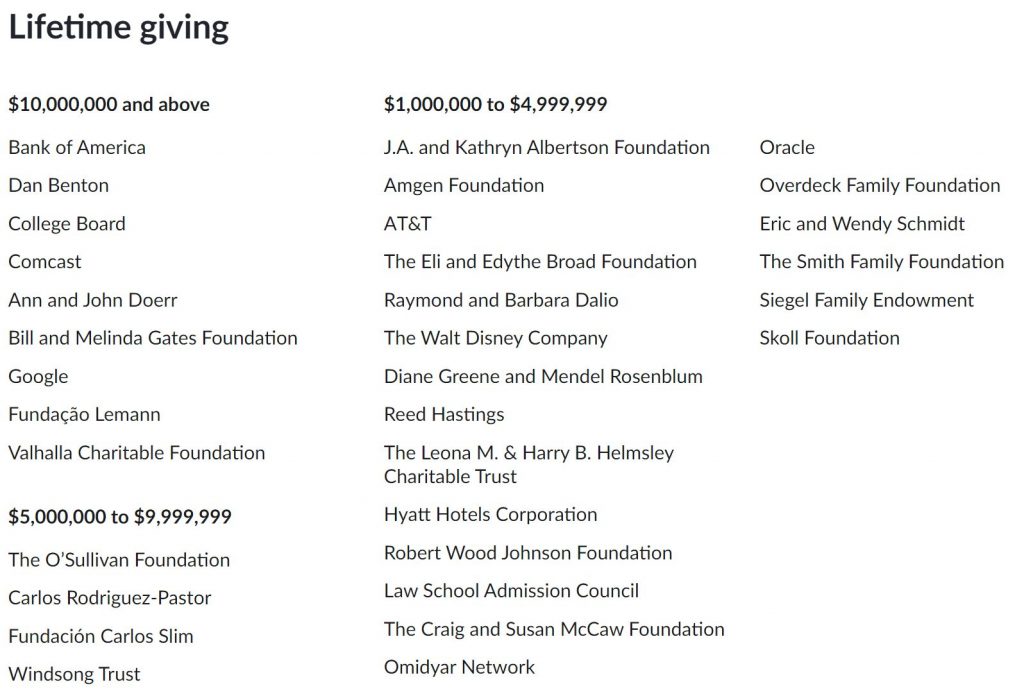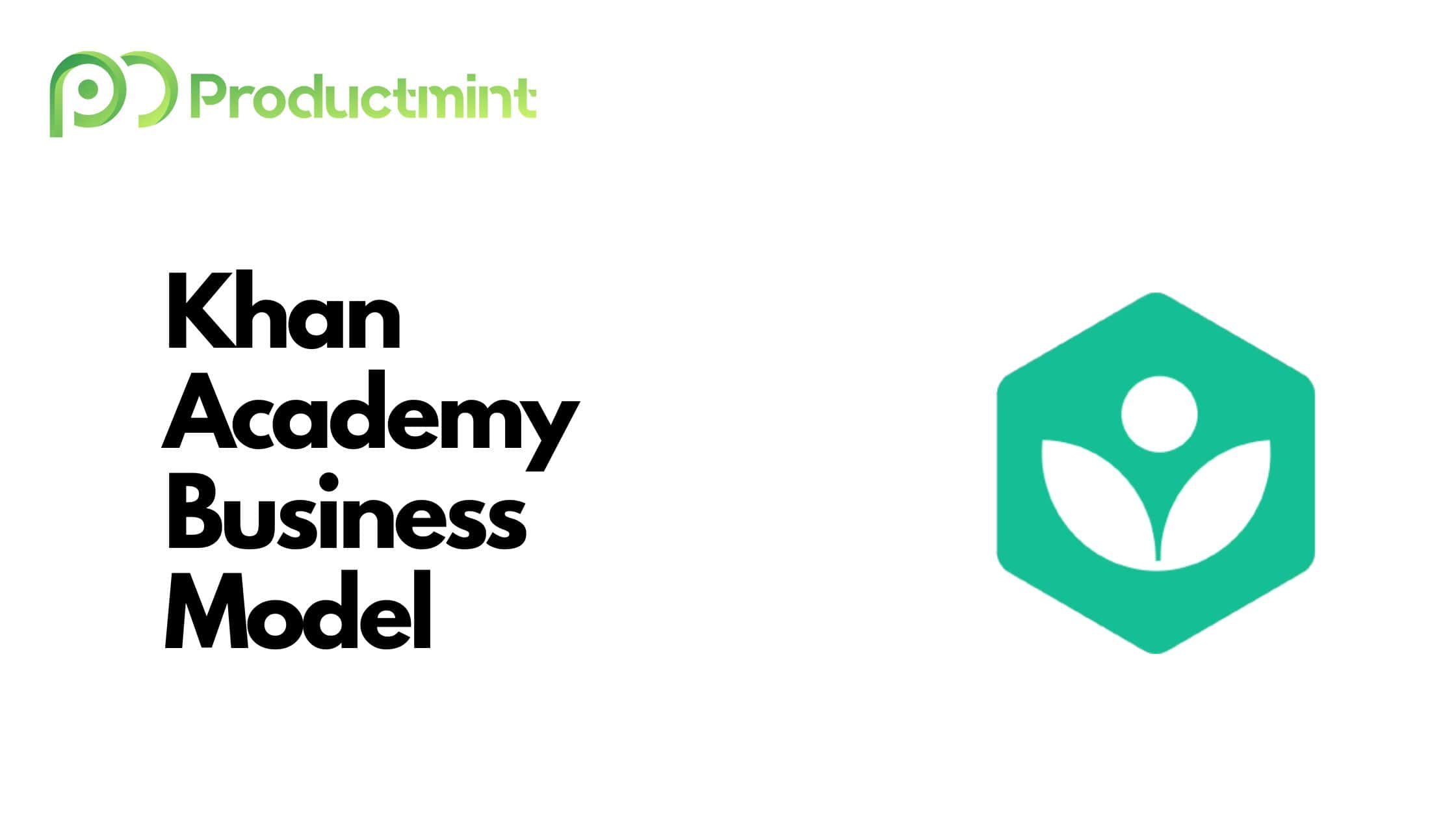Executive Summary:
Khan Academy is an online learning platform offering instructional videos on subjects like mathematics, economics, computer science, and more.
Khan Academy makes money via donations, tuition fees from its own schools, SAT prep materials, and merchandise sales.
Founded in 2008, Khan Academy has become one of the world’s most frequented online learning platforms. More than 30 million people visit its platform every month.
What Is Khan Academy?
Khan Academy is a nonprofit organization that creates instructional videos on topics such as computing, mathematics, economics, science, history, art, and more.
Course content is primarily targeted at students below 18 years of age, attending anything from kindergarten to high school.
Videos are created in digestible 5-to-20-minute chunks, tailormade for a viewing experience on computer and mobile devices.
These videos are then accompanied by short quizzes, which test a student’s understanding of the previously introduced material.
Besides educating students on various school-related topics, Khan Academy also offers courses on prepping for various tests such as the SAT or LSAT.
Apart from its online content, Khan Academy works together with teachers (free of charge) to develop a better learning experience for their classes – and thus increase their students’ rate of success.
Khan Academy content can be accessed via the firm’s website, its mobile and tablet applications (available on Android and iOS), as well as via its YouTube channel.
The nonprofit offers courses in over 40 languages, including English, Spanish, Hindi, or French.
Khan Academy Company History
Khan Academy, headquartered in Mountain View, California, was founded in 2008 by Salman Khan (CEO).
Khan was born in Metairie, Louisiana, to Bengali immigrants in 1976. For most of his childhood, he was raised by his mother who held a job as a 7-Eleven cashier.
Early on, he began developing an interest in formal and natural sciences. During his high school years, he placed in national math competitions and eventually became the valedictorian of his class.
To fulfill his thirst for high-quality education, he enrolled at the Massachusetts Institute of Technology (MIT). Khan graduated from MIT in 1998 with three degrees: two bachelor’s degrees in electrical engineering/computer science and mathematics; and a master’s degree in electrical engineering.
After graduating from MIT, he ended up working in tech-related roles in the Valley. When the tech bubble burst in the early 2000s, Khan decided to go back to his notebook and pen – pursuing an MBA at Harvard Business School.
Post-graduation, he became an analyst at a Boston based hedge fund where he would work for 5 years. One day in 2004, his cousin Nadia, knowing of Khan’s knack for formal sciences, asked him to tutor her in mathematics.
Khan started out teaching his cousin using Yahoo Doodle to work through the school assignments. He even added some JavaScript programs that would record her progress during those sessions.
Eventually, when other family members started asking for help, Khan logged his lessons and lectures and began uploading them to YouTube.
His intentions, as he’d later describe, were completely altruistic. He simply wanted to find a way to improve the delivery of his content. What he did not expect was that these videos would eventually take on a life of their own.
During the next few years, Khan uploaded hundreds of videos to YouTube, which began to garner millions and millions of views. In 2009, he finally decided to quit his day job and focus on Khan Academy full-time.
When he first started out, venture capital investors were offering to invest in the organization, but requiring Khan to set it up as a for-profit company.
He ultimately declined that request, though. In an interview with GeekWire, Khan elaborated on his reason for pursuing the non-profit route:
“I enjoyed so many people using these videos. That reward felt like so much, that I didn’t want to mess with that vision. I didn’t want to mess with my own incentives, where I was doing it purely out of joy. As soon as you do a for-profit if someone comes to you and says, “Hey, we’ll acquire it for half-a-billion dollars,” that’s tempting, but now we say, no, our mission comes first. You actually can’t acquire us.”
While Khan’s intentions were extremely noble, his pockets soon began to dry up. After all, he funded Khan Academy with his own savings, which began to diminish day by day. For instance, Khan Academy launched its website in late 2008 (while the founder was still employed) to decrease its dependence on YouTube.
Luckily, Khan’s videos made it into the homes of some very influential and wealthy people who soon after began endorsing the socially conscious entrepreneur. Ann Doerr, the wife of venture capitalist John Doerr, made the first-ever significant donation to Khan Academy.
But Khan’s biggest leap probably came in 2010 when Bill Gates publicly endorsed the non-profit in a crowd of over 2,000 at the Aspen Ideas Festival.
Gates would go on to provide Khan Academy with a 2-year grant via the Bill and Melinda Gates Foundation. Today, the Gates’ are lifetime donors, contributing more than $10 million every year to the organization.
The Gates endorsement (and subsequent donations) helped to accelerate Khan’s endeavor – and propelled his persona to extreme heights. In early 2010, media began calling him the “world’s teacher” and the “Messiah of Math”.
Not everyone was agreeing with that sentiment, though. A 2012 article by the Washington Post outlined how many of his video lectures entailed significant errors.
Despite these hiccups, Khan Academy’s popularity continued to rise. The increased awareness allowed Khan and team to raise more money, which in turn was invested in a variety of features and products.
For instance, in 2012, Khan Academy launched its first tablet application on the iPad. Other devices and operating systems, such as Android, would follow on.
The organization also began partnering up with other companies and educational institutions to offer better learning solutions. In 2014, Khan Academy announced a collaboration with the College Board to bring free SAT test prep software to the masses.
On the backbone of these partnerships, Khan Academy even launched its own physical school called Khan Lab School. The school promotes an independent learning environment where enrolled students can pursue any topic they deem interesting.
In 2020, the company experienced exceptional as well as unprecedented growth as a result of the coronavirus pandemic.
Before the pandemic, 18 million users were visiting Khan Academy every month. Traffic increased by 250 percent ever since, urging CEO Khan to publicly ask for more donations to keep the business afloat.
And people have followed through. Elon Musk, for instance, decided to donate $5 million to Khan Academy in January 2021. Other prominent investors have followed ever since.
Throughout 2021 and 2022, Khan Academy continued to partner with schools and other institutions to bring its material to as many students as possible.
One of those initiatives was the launch of the Khan World School in partnership with Arizona State University back in April 2022.
Today, Khan Academy offers over 4,000 hours of educational video content. The nonprofit organization employs close to 1,000 people. Sal Khan still records a third of all Khan Academy tutorials.
How Does Khan Academy Make Money?
Khan Academy makes money via donations, tuition fees from its own schools, SAT prep materials, and merchandise sales.
Let’s dive into each of these income streams in more detail below.
Donations
The bulk of Khan Academy’s income originates from donors. An overview of the current donor base can be found here:

Some of the most prominent donors include Google, Bank of America, Bill and Melinda Gates, AT&T, Oracle, The Walt Disney Company, and Elon Musk.
Donors either provide money on a one-time, monthly, or annual basis. Those that at least contribute $50,000 to Khan Academy will be listed in the above-mentioned page.
Khan Lab School & World School
Khan Lab School was launched in 2014. It’s a private school that offers a differentiated learning experience to students from age 5 to 18.
The school acts as a testing ground for many new approaches to class-based learning. Sal Khan hopes to eventually share his learnings with educators around the world.
Khan Academy generates revenue via tuition fees that it charges for attending the school. Enrolled students (or rather their parents) currently pay $29,000 in annual tuition.
The money allows Khan to hire teachers, acquire educational aids such as tablets or painting material, and afford rent.
Similarly, the Khan World School, launched in April 2022, is a virtual school for high schoolers that costs $10,000 per year.
The school is focused on mastery, meaning that students actually understand the topics they learn.
Mastery is assessed by recording a student’s face during an assignment and requiring them to explain their reasoning out loud.
SAT Prep
In 2014, Khan Academy started offering SAT preparation courses as a result of its partnership with the College Board.
The partnership gave Khan Academy access to actual test questions. This would allow the team to spot weaknesses in the current test setup and create a sophisticated learning program to prepare for the SAT.
Furthermore, Khan Academy launched an accompanying software that determines weak areas in a student’s submission.
An article published by Forbes revealed that Khan Academy grosses $10 million a year from its prep courses (also including the LSAT or Praxis). In all likeliness, its partners compensate the organization in exchange for providing free preparation courses.
Merchandise Sales
The last and likely small source of revenue that Khan Academy generates comes from selling merchandise.
Supporters can purchase all kinds of different items, ranging from t-shirts to hats and mugs.
Selling merchandise is common among companies that offer access to free information or tools. Organizations such as Desmos or Wikipedia have all used to it to up their income.
Another perk of offering merchandise is that it raises awareness about the organization that’s selling it. Plus, it gives fans a chance to support an organization or cause they’re passionate about.
Khan Academy Funding, Valuation & Revenue
According to Crunchbase, Khan Academy has raised a total of $16.2 million across 5 outside funding rounds. The organization’s main backers are the Amgen Foundation as well as the Omidyar Network.
Neither a valuation nor revenue (or in this case: donation) figures were ever announced by the non-profit.
Nevertheless, the nonprofit does disclose the number of donations it receives as well as who’s donating. In 2020, Khan Academy has received donations of $62 million from the likes of the Gates Foundation, Netflix CEO and founder Reed Hastings, Google, and many more.
Furthermore, the organization grossed another $10 million from providing prep courses on the SAT, LSAT, and Praxis.
Who Owns Khan Academy?
Nonprofit organizations, just like Khan Academy (which’s registered as a 501(c)(3) nonprofit organization), do not have an ownership structure.
As such, when it receives donations, its shareholding structure is not altered. In contrast, many for-profit startups use equity financing to fund the first few years of their operation.
Being a nonprofit offers a few benefits. First, nonprofits are exempt from paying income tax on net income (but they still have to pay state and property tax).
Second, because nonprofits do not have owners, they don’t face pressure from investors to report profits. Third, nonprofits are oftentimes able to attract employees that work on a voluntary basis.
